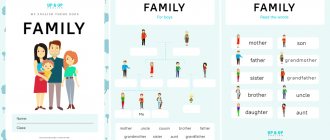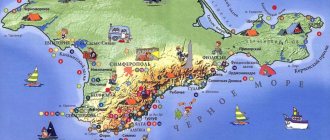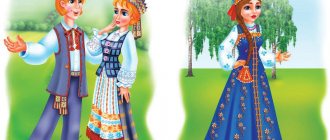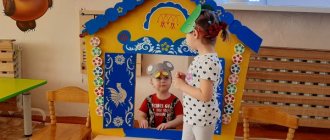Dear visitors of the site www.englishhobby.ru! On this page you will find materials on the following topics: English for children. English lessons in kindergarten. English for children. English at preschool educational institution. English for kids. Playful English for kids. English for kids download. Playful English for kids for free. Download free English for kids. Children's first English lesson. First English lessons + for kids. First English lesson + for kids. First English lessons + for kids. English lessons for kids first lessons. Crossword puzzle “Australia” in English.
Notes of OOD in English (20 notes) lesson plan (senior group)
Lesson outline on the topic: “Colors”. (senior group) (Stereotyping-situational stage - formation of automation).
Goal: development of lexical and grammatical skills using a fairy tale on the theme “Colors”.
Tasks:
1. Teach children new lexical units on the topic “Colors”: purple, golden, beige, turquoise.
2. Continue to teach children to act according to the model.
3. Continue teaching children to use speech patterns: “It is…”, “I like…” “What is it?”.
Language material for active use in speech:
-names of colors (green, yellow, red, blue, pink, brown, orange, grey, white, black, purple, golden, beige, turquoise).
Language material for recognition:
-commands (Let's see it, Let's repeat, Please, take your chairs and go out!)
Expected results:
1. Children will be able to act according to the model.
2. Children will learn to use speech patterns “It is…”, “I like…” “What is it?” using LE on the topic: “Colors”.
3. The children mastered the proposed language material.
1. Organizational moment. (3 min)
T: “Hello, my dear children! I am glad to see you! How are you?”
CH: “I am fine”
T: “Very well! I am fine too!”
T: “Guys, let’s start our lesson by repeating our greeting poem! Turn to each other and say good morning!” (Poem)
SN: Good morning, good morning,
Good morning to you,
Good morning, good morning,
I'm glad to see you.
T: “Good for you! Well done!”
2. Main part. (21 min)
T: “Children, they are many colors in English. Let's see it! (On the board there are cards of the colors that the children already know (Green, red, blue, yellow, brown, white, black, orange, grey, pink)). Please name these colors. For example, it is green. What is it?” (Children take turns calling the colors, then ask each other). (2 min)
T: “That`s right! And now I will tell you a fairy tale about the octopus Gosha. I'm sure you'll like it! Only some of the words in it are written in English, so when you hear them, say them out loud in Russian! All right? Agreed?
SN: “Yes”
T: “In the huge deep ocean lives the octopus Gosha. He likes everything colorful, beautiful, bright. That's why he loves to look at small fish that move in moving schools here and there... They are very bright, colorful and cheerful!
And for many days the octopus dreams that someday he will learn to draw, and that he will always be surrounded by colorful paintings. And so, Gosha began to look for paints, because there is so much on the bottom of the ocean! But he always came across something wrong - shipwrecks, chests, even skeletons...
Finally, he found jars of paints among other things, lined them up in front of him and began to examine them. “Oh, what wonderful, magnificent colors!” - Gosha said.
“Here is green, it’s like algae; This is yellow, it’s like sand.”
Seeing a jar of red paint, Gosha thought about it. What does red look like? Oh yes! “red is like coral, and blue is like the sky!” Even an octopus living in the depths of the ocean knows what color the sky is, because it also sometimes looks up...
At that moment, a school of fish swam by. They were so beautiful and colorful! And pink, and brown, and orange, and grey! And everyone was scurrying up and down!
And Gosha, too, admiring them, looked up and down! And so, when he looked up again, the octopus saw the white sail of a yacht through the water. It was beautiful too. He liked white as well as other colors.
Gosha, returning to his jars and remembering what colors he had seen during the day, began to test his memory. Looking at his “treasures,” he said: “green looks like grass and algae; - yellow looks like sand and the sun; -red, same as corals; - blue, the same as the sky! And these colors - pink, brown, orange, gray - are like the scales of cheerful little fish that swam up and down.
And Gosha had two more colors in jars. One of them is white, like the sail of the yacht he saw that day. And the other color is black. Gaucher didn't really like this color.
He reminded him of the not best days of his childhood, when his mother scolded little Gosha because his neck was dirty and black. “And how did I manage to get my neck dirty, being in the water all the time?” - the matured Gosha sometimes thought.
Now he understood his mother. I also understood that a dirty and black neck is ugly. But, the octopus thought, if you paint everything black, and then draw patterns or fish on top in different, bright colors, it will be beautiful...
Gosha is very tired. He went to bed and fell asleep happy. Because tomorrow he will DRAW!” (8 min)
T: “Guys, did you like the fairy tale?”
SN: “Yes!”
T: “That's great! Wonderful! But you and I don’t know the names of all flowers, would you like to know a few more? Then look at our magical flower! Look at the magic flower! What colors are its petals?
CH: “purple, golden, beige, turquoise.”
T: “That`s right! Purple will be purple in English. Repeat, please! For example, a purple ball. Golden will be golden. Repeat, please all together! For example, a golden ball. Beige will be beige, a beige ball. And turquoise is turquoise, a turquoise ball. Let's repeat!" (together and individually). (5 min)
T: “Good for you, my dears!” Well, have you stayed too long? Stand up, my children!” (Physical education minute)
When I see red I put my hands on my head.When I see blue I touch my shoe. When I see green I wash my face real clean. When I see yellow I wave to the fellows. When orange is found I put my hands on the ground. When I see pink I think, I think, I think. (2 times)
T: “Very well! Sit down, please!” (2 min)
T: “Now let’s mix our paints (pictures with colors are mixed and turned face down) and play “Yes or no,” okay?” (Children take turns taking out one card with a color, look at the color, but do not show it to anyone, and others must guess this color using the questions “Is it...?”. The one who guesses takes the place of the leader).
T: “Kira, is it red?”
SN: “No, it isn`t” (Further according to the sample).
T: “That's perfectly correct. Absolutely right." (4 min)
3. Final part. (2 min)
T: “Guys, what new colors did we learn today? What did you like most about today's lesson?
SN: “I found out that purple is purple in English”
T: “Well done! Our lesson is over! Thanks for good job! Please, take your chairs and go out!”
What is a bilingual kindergarten
Agree that fluency in English is a mandatory requirement for successful professional development in many areas. How would you like your heir to study or train abroad? Got a well-paid position in an international corporation or a large domestic company? To achieve such results, young ladies and gentlemen need to be fluent in a foreign language.
Scientists (and not only British ones, ha-ha) have proven that a person is able to master English at the native level only if he studies the language from childhood with native speakers. The English-speaking environment is the main secret! To lay a good foundation for language acquisition, it is worth sending your child to a bilingual kindergarten.
Bilingual kindergartens and schools are an investment in the child’s future
Bilingual education has many advantages over conventional education. Children master a foreign language as a second native language, broaden their horizons, and become familiar with the main components of Anglo-American culture. They have a high degree of adaptability to change, become tolerant and more easily integrate into a new society.
There are several bilingual preschool institutions in Moscow. The most famous of them:
- Heritage School is an international primary school and kindergarten, teaching according to the British Early Years Foundation Stage (EYFS) program and the Russian state school curriculum (and Mr Great and I cannot be happier that we chose this particular school for our children!);
- P'titCREF is a trilingual kindergarten that unites children who speak English, French and Russian.
- Baby-Bilingual Club - a club for early language development, provides complete immersion in the language environment;
- English Nursery & Primary School is a kindergarten and primary school that combines the best traditions of British and Russian education; education is conducted by immersion in an English-speaking environment.
To make sure you don’t make a mistake in your choice, I recommend using my husband’s proprietary checklist! This is what we were guided by when making our choice.
Mr Great checklist for choosing a bilingual kindergarten
- Find out what methodology the kindergarten uses (content-based or subject-based). I repeat, content is more effective;
- Ask about the teaching staff. It is important that most teachers are native speakers of a foreign language;
- Make sure that subject teachers do not change every month; a stable teaching staff is important, so you won’t have to worry that in the middle of the school year a native speaker teacher will not be replaced by a Russian-speaking colleague;
- Study the extracurricular life of the school, not only classes are important, but also the general atmosphere, cultural integration in an interlingual environment;
- Find out under what conditions the school building is used, this is important; it will be extremely inconvenient if, at the height of the school year, the school fails to renew the lease agreement, and the kindergarten will have to move to the other end of the city.
And most importantly, dear parents: when choosing a bilingual preschool for your child, take the trouble to attend a trial lesson. This will allow you to assess how suitable this kindergarten is for your child and meets its goals and objectives. Personal impressions are the most important!
Always yours, Mrs Britain
What is bilingualism and who are bilinguals?
Let me give you a little theory:
Bilingualism, or bilingualism, is the ability of a person to use two languages as native ones. Bilinguals can move freely from one language to another and have native-level proficiency in both languages. A very valuable skill, don’t you think?
For countries with several official languages, bilingualism is considered quite common. For example, Switzerland... Ah, Switzerland! Mr Great still can’t forget our trip to Gruyères, they make excellent cheese, I must say! But let's not get distracted! This country has four official languages, the majority of the population speaks at least two of them. Children learn languages in kindergartens, schools, and when communicating with peers in everyday life.
Why Switzerland, why go far - remember the experience of the Soviet Union in terms of bilingualism. In the USSR, Russian was the state language, however, in each of the republics there was bilingual education, and two languages were taught in schools - Russian and native. Soviet schoolchildren from the union republics and their parents didn’t even see anything special in their bilingualism, can you imagine?
Disadvantages of bilingual kindergartens
You probably think that everything is too good, that this Mrs. Britain is hiding something. I would definitely think so if I were you! To be honest, there are also disadvantages. So, what disadvantages are you worth knowing about:
- lack of native-speaking teachers in schools;
- the possibility of losing contact with the culture of the native language;
- relatively high cost of educational services.
Be careful, due to the lack of native teachers, in some bilingual kindergartens classes are taught by Russian-speaking English teachers. This is fraught with the fact that the children are given incorrect pronunciation, and words are not always used correctly. I warned you!
But if the emphasis in learning shifts to a foreign language, the child may experience difficulty communicating in his native language. His vocabulary of his native speech is deteriorating; the baby may even completely switch to a foreign language in communication. It is important to monitor the situation and maintain balance.
Bilingual kindergartens are expensive. I won’t deny that few Russians can afford them because of their high cost. In justification, I will cite the British proverb “Money spent on the brain is never spent in vain” (Money spent on education is never wasted.). Bilingual educational institutions are private institutions, so the objectively high cost is a given.
What are the benefits of bilingualism
Bilingualism today is not a fad, but an urgent necessity. Even Mr Great was forced to learn Russian in order to get a place in the company's Moscow office. But I dare say that the process not only was not a burden to him, but also brought quite a bit of pleasure! I'll tell you a secret, Mr Great even shirked his household duties, justifying himself by the need to learn Russian words! So, today any serious company is already operating in the international market or is striving to do so. Therefore, perfect knowledge of a foreign language is a must-have for a highly paid specialist and a successful professional in any field!
Young ladies and gentlemen who learn a foreign language from kindergarten have excellent memory and developed thinking. As adults, they have a broader horizon, they are less susceptible to prejudices of any kind and it is easier to socialize in a new environment. Bilinguals learn the third and subsequent languages more easily, especially from the same language group. Both humanities and mathematical sciences are equally easy for them.
Considering all these advantages, many parents today choose bilingual education for their children. First in a bilingual kindergarten, then in a similar school.
Key benefits of bilingual practice
To summarize, I will try to highlight for you the most important advantages that bilingual education has. So:
- communication skills develop;
- memory and logic are stimulated;
- vocabulary and conceptual stock expands.
A bilingual child studies the history and culture of both countries. He develops fluent spoken language and correct pronunciation, and instantly switches easily from one language to another. Bilingual children are special; as they get older, they have the ability to quickly change activities, concentrate better and can solve two problems at the same time. It’s a pleasure to watch such kids, I tell you!





